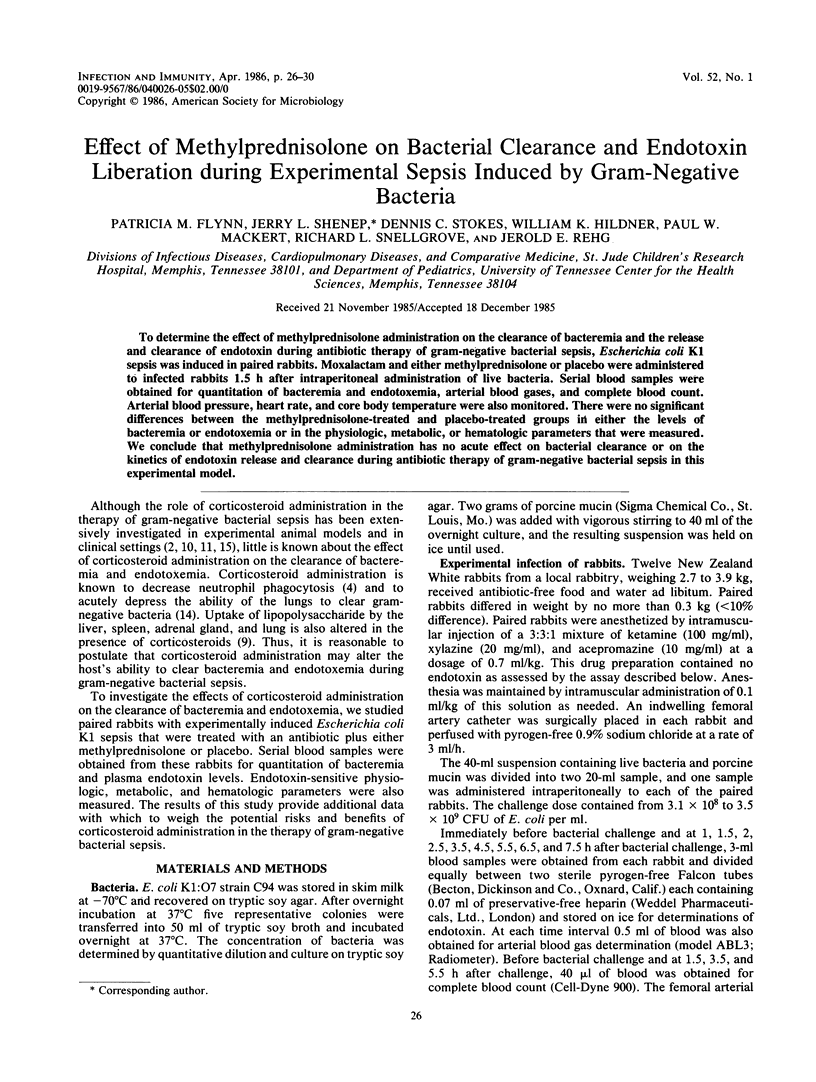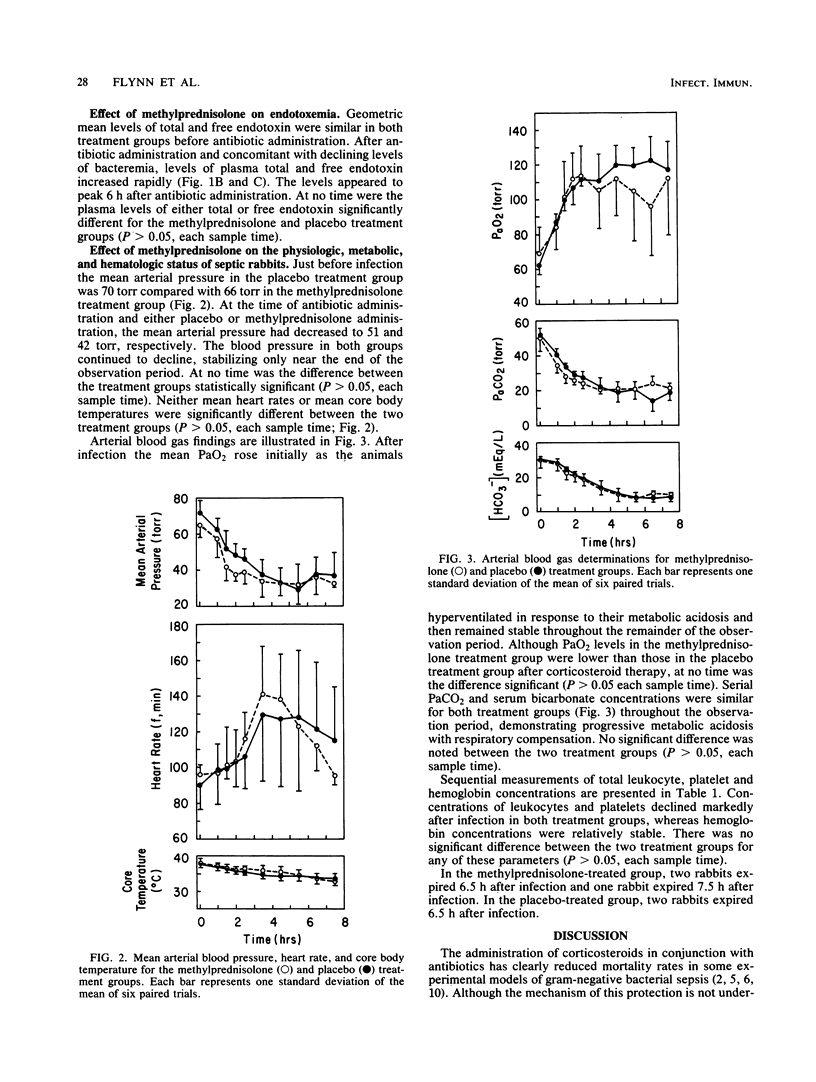Abstract
To determine the effect of methylprednisolone administration on the clearance of bacteremia and the release and clearance of endotoxin during antibiotic therapy of gram-negative bacterial sepsis, Escherichia coli K1 sepsis was induced in paired rabbits. Moxalactam and either methylprednisolone or placebo were administered to infected rabbits 1.5 h after intraperitoneal administration of live bacteria. Serial blood samples were obtained for quantitation of bacteremia and endotoxemia, arterial blood gases, and complete blood count. Arterial blood pressure, heart rate, and core body temperature were also monitored. There were no significant differences between the methylprednisolone-treated and placebo-treated groups in either the levels of bacteremia or endotoxemia or in the physiologic, metabolic, or hematologic parameters that were measured. We conclude that methylprednisolone administration has no acute effect on bacterial clearance or on the kinetics of endotoxin release and clearance during antibiotic therapy of gram-negative bacterial sepsis in this experimental model.
Full text
PDF




Selected References
These references are in PubMed. This may not be the complete list of references from this article.
- Greisman S. E., DuBuy J. B., Woodward C. L. Experimental gram-negative bacterial sepsis: prevention of mortality not preventable by antibiotics alone. Infect Immun. 1979 Aug;25(2):538–557. doi: 10.1128/iai.25.2.538-557.1979. [DOI] [PMC free article] [PubMed] [Google Scholar]
- Greisman S. E. Experimental Gram-negative bacterial sepsis: optimal methylprednisolone requirements for prevention of mortality not preventable by antibiotics alone. Proc Soc Exp Biol Med. 1982 Sep;170(4):436–442. doi: 10.3181/00379727-170-41455. [DOI] [PubMed] [Google Scholar]
- Hammerschmidt D. E., White J. G., Craddock P. R., Jacob H. S. Corticosteroids inhibit complement-induced granulocyte aggregation. A possible mechanism for their efficacy in shock states. J Clin Invest. 1979 Apr;63(4):798–803. doi: 10.1172/JCI109365. [DOI] [PMC free article] [PubMed] [Google Scholar]
- Heine K. J., Shallcross J. C., Jr, Trachtenberg L. S., Galland R. B., Polk H. C., Jr A reassessment of the influence of steroids on neutrophil phagocytosis. Am Surg. 1983 Apr;49(4):221–224. [PubMed] [Google Scholar]
- Hinshaw L. B., Beller-Todd B. K., Archer L. T., Benjamin B., Flournoy D. J., Passey R., Wilson M. F. Effectiveness of steroid/antibiotic treatment in primates administered LD100 Escherichia coli. Ann Surg. 1981 Jul;194(1):51–56. doi: 10.1097/00000658-198107000-00009. [DOI] [PMC free article] [PubMed] [Google Scholar]
- Hinshaw L. B., Beller B. K., Archer L. T., Flournoy D. J., White G. L., Phillips R. W. Recovery from lethal Escherichia coli shock in dogs. Surg Gynecol Obstet. 1979 Oct;149(4):545–553. [PubMed] [Google Scholar]
- Hoffman S. L., Punjabi N. H., Kumala S., Moechtar M. A., Pulungsih S. P., Rivai A. R., Rockhill R. C., Woodward T. E., Loedin A. A. Reduction of mortality in chloramphenicol-treated severe typhoid fever by high-dose dexamethasone. N Engl J Med. 1984 Jan 12;310(2):82–88. doi: 10.1056/NEJM198401123100203. [DOI] [PubMed] [Google Scholar]
- Munford R. S., Dietschy J. M. Effects of specific antibodies, hormones, and lipoproteins on bacterial lipopolysaccharides injected into the rat. J Infect Dis. 1985 Jul;152(1):177–184. doi: 10.1093/infdis/152.1.177. [DOI] [PubMed] [Google Scholar]
- Pitcairn M., Schuler J., Erve P. R., Holtzman S., Schumer W. Glucocorticoid and antibiotic effect on experimental gram-negative bacteremic shock. Arch Surg. 1975 Aug;110(8):1012–1015. doi: 10.1001/archsurg.1975.01360140156030. [DOI] [PubMed] [Google Scholar]
- Schumer W. Steroids in the treatment of clinical septic shock. Ann Surg. 1976 Sep;184(3):333–341. doi: 10.1097/00000658-197609000-00011. [DOI] [PMC free article] [PubMed] [Google Scholar]
- Shenep J. L., Barton R. P., Mogan K. A. Role of antibiotic class in the rate of liberation of endotoxin during therapy for experimental gram-negative bacterial sepsis. J Infect Dis. 1985 Jun;151(6):1012–1018. doi: 10.1093/infdis/151.6.1012. [DOI] [PubMed] [Google Scholar]
- Shenep J. L., Mogan K. A. Kinetics of endotoxin release during antibiotic therapy for experimental gram-negative bacterial sepsis. J Infect Dis. 1984 Sep;150(3):380–388. doi: 10.1093/infdis/150.3.380. [DOI] [PubMed] [Google Scholar]
- Skornik W. A., Dressler D. P. The effects of short-term steroid therapy on lung bacterial clearance and survival in rats. Ann Surg. 1974 Apr;179(4):415–421. doi: 10.1097/00000658-197404000-00006. [DOI] [PMC free article] [PubMed] [Google Scholar]
- Sprung C. L., Caralis P. V., Marcial E. H., Pierce M., Gelbard M. A., Long W. M., Duncan R. C., Tendler M. D., Karpf M. The effects of high-dose corticosteroids in patients with septic shock. A prospective, controlled study. N Engl J Med. 1984 Nov 1;311(18):1137–1143. doi: 10.1056/NEJM198411013111801. [DOI] [PubMed] [Google Scholar]


